英语教师资格证语音课型教案模板
- 格式:doc
- 大小:34.50 KB
- 文档页数:6
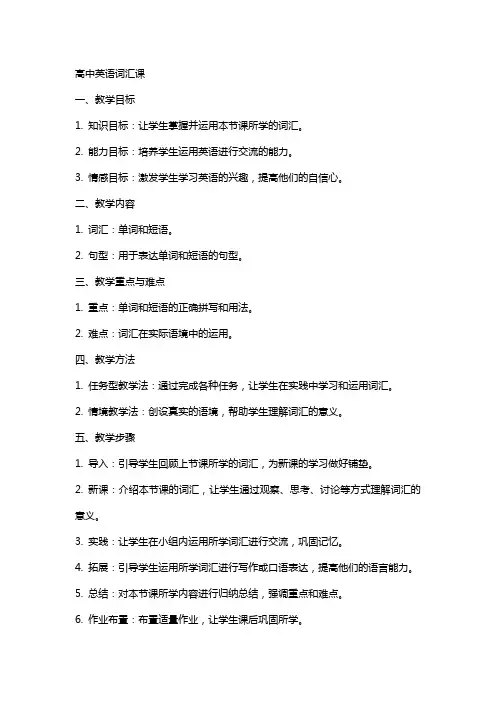
高中英语词汇课一、教学目标1. 知识目标:让学生掌握并运用本节课所学的词汇。
2. 能力目标:培养学生运用英语进行交流的能力。
3. 情感目标:激发学生学习英语的兴趣,提高他们的自信心。
二、教学内容1. 词汇:单词和短语。
2. 句型:用于表达单词和短语的句型。
三、教学重点与难点1. 重点:单词和短语的正确拼写和用法。
2. 难点:词汇在实际语境中的运用。
四、教学方法1. 任务型教学法:通过完成各种任务,让学生在实践中学习和运用词汇。
2. 情境教学法:创设真实的语境,帮助学生理解词汇的意义。
五、教学步骤1. 导入:引导学生回顾上节课所学的词汇,为新课的学习做好铺垫。
2. 新课:介绍本节课的词汇,让学生通过观察、思考、讨论等方式理解词汇的意义。
3. 实践:让学生在小组内运用所学词汇进行交流,巩固记忆。
4. 拓展:引导学生运用所学词汇进行写作或口语表达,提高他们的语言能力。
5. 总结:对本节课所学内容进行归纳总结,强调重点和难点。
6. 作业布置:布置适量作业,让学生课后巩固所学。
教案模板:1. 教学目标2. 教学内容3. 教学重点与难点4. 教学方法5. 教学步骤逐字稿:1. 导入(5分钟)回顾上节课所学的词汇引入本节课的主题2. 新课(15分钟)介绍本节课的词汇讲解词汇的拼写、意义和用法3. 实践(10分钟)学生在小组内运用所学词汇进行交流教师巡回指导,纠正错误4. 拓展(10分钟)引导学生运用所学词汇进行写作或口语表达学生展示,教师评价5. 总结(5分钟)归纳总结本节课所学内容强调重点和难点6. 作业布置(5分钟)布置适量作业,让学生课后巩固所学六、教学评价1. 评价方式:采用课堂表现、作业完成情况和小测验等多种方式进行评价。
2. 评价内容:学生对词汇的掌握程度、运用能力以及课堂参与度。
七、教学反思1. 反思内容:教学过程中的成功与不足之处。
2. 反思方式:通过学生反馈、自我总结和同行交流等方式进行。
八、教学拓展1. 拓展内容:与本节课主题相关的词汇和短语。
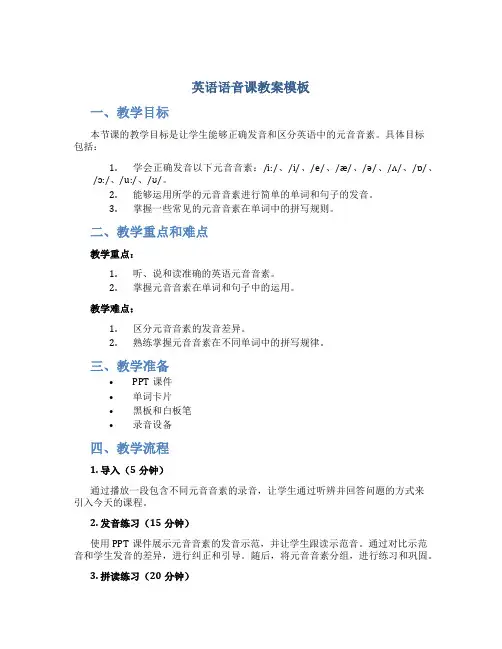
英语语音课教案模板一、教学目标本节课的教学目标是让学生能够正确发音和区分英语中的元音音素。
具体目标包括:1.学会正确发音以下元音音素:/i:/、/i/、/e/、/æ/、/ə/、/ʌ/、/ɒ/、/ɔ:/、/u:/、/ʊ/。
2.能够运用所学的元音音素进行简单的单词和句子的发音。
3.掌握一些常见的元音音素在单词中的拼写规则。
二、教学重点和难点教学重点:1.听、说和读准确的英语元音音素。
2.掌握元音音素在单词和句子中的运用。
教学难点:1.区分元音音素的发音差异。
2.熟练掌握元音音素在不同单词中的拼写规律。
三、教学准备•PPT课件•单词卡片•黑板和白板笔•录音设备四、教学流程1. 导入(5分钟)通过播放一段包含不同元音音素的录音,让学生通过听辨并回答问题的方式来引入今天的课程。
2. 发音练习(15分钟)使用PPT课件展示元音音素的发音示范,并让学生跟读示范音。
通过对比示范音和学生发音的差异,进行纠正和引导。
随后,将元音音素分组,进行练习和巩固。
3. 拼读练习(20分钟)将一些包含元音音素的单词卡片分发给学生,并要求他们按顺序发音。
教师辅助学生进行纠音和巩固。
4. 句子模仿(10分钟)教师给出一些句子的示范,并要求学生模仿发音。
鼓励学生参与互动,自由发挥,加深对元音音素的理解和运用。
5. 拓展活动(10分钟)在课堂的最后,教师可以安排一些拓展活动,如配对游戏或听力练习,以加深学生对元音音素的掌握程度。
五、课堂练习与作业1.跟随PPT课件中的发音示范,进行元音音素的发音练习。
2.完成课后练习册上关于元音音素的练习题。
六、教学反思本节课通过多种形式的活动让学生参与到英语元音音素的学习中,激发了学生的学习兴趣。
但在后续的教学中,需要更加注重学生的巩固训练和反馈,以提高他们的语音准确性和学习效果。
同时,还可以结合实际情景和应用,让学生体会元音音素在日常生活中的运用和意义,进一步增强他们的学习动力。
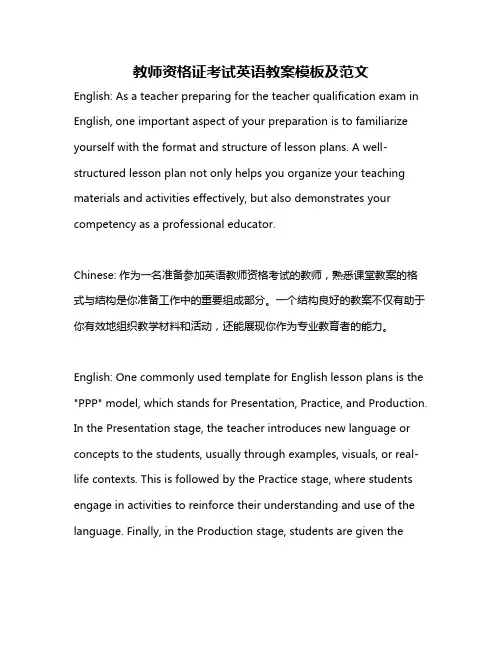
教师资格证考试英语教案模板及范文English: As a teacher preparing for the teacher qualification exam in English, one important aspect of your preparation is to familiarize yourself with the format and structure of lesson plans. A well-structured lesson plan not only helps you organize your teaching materials and activities effectively, but also demonstrates your competency as a professional educator.Chinese: 作为一名准备参加英语教师资格考试的教师,熟悉课堂教案的格式与结构是你准备工作中的重要组成部分。
一个结构良好的教案不仅有助于你有效地组织教学材料和活动,还能展现你作为专业教育者的能力。
English: One commonly used template for English lesson plans is the "PPP" model, which stands for Presentation, Practice, and Production. In the Presentation stage, the teacher introduces new language or concepts to the students, usually through examples, visuals, or real-life contexts. This is followed by the Practice stage, where students engage in activities to reinforce their understanding and use of the language. Finally, in the Production stage, students are given theopportunity to apply what they have learned in a more creative and authentic way.Chinese: 一种常用的英语教案模板是“PPP”模型,即介绍、练习和实践。
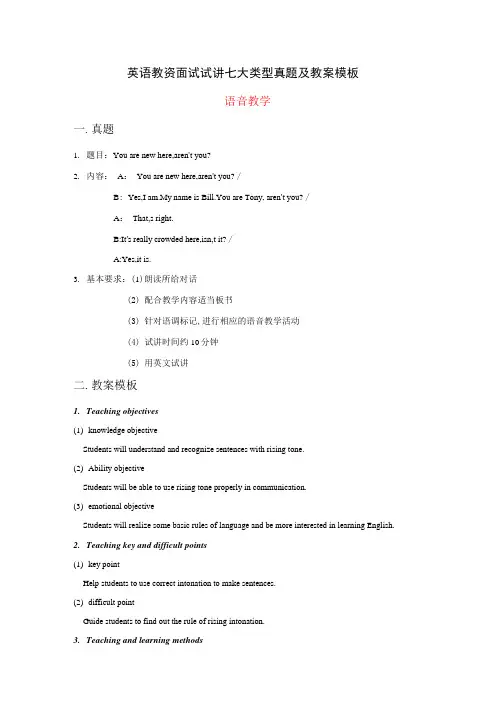
英语教资面试试讲七大类型真题及教案模板语音教学一.真题1.题目:You are new here,aren't you?2.内容:A:You are new here,aren't you? /B: Yes,I am.My name is Bill.You are Tony, aren't you? /A:That,s right.B:It's really crowded here,isn,t it? /A:Yes,it is.3.基本要求:(1)朗读所给对话(2)配合教学内容适当板书(3)针对语调标记,进行相应的语音教学活动(4)试讲时间约10分钟(5)用英文试讲二.教案模板1.Teaching objectives(1)knowledge objectiveStudents will understand and recognize sentences with rising tone.(2)Ability objectiveStudents will be able to use rising tone properly in communication.(3)emotional objectiveStudents will realize some basic rules of language and be more interested in learning English.2.Teaching key and difficult points(1)key pointHelp students to use correct intonation to make sentences.(2)difficult pointGuide students to find out the rule of rising intonation.3.Teaching and learning methodsTask-based language teaching method :cooperative learning method; individual learning method. 4.Teaching proceduresStep1 :Lead inStudents will listen to a song and try to sing along with it.Teacher reminds them of the last word of each sentence.Step2:PresentationTeacher will choose two students to read the dialogue.Then students listen to the tape and find out the difference between their intonation and the speakers.Students are encouraged to underline the sentences.Teacher will also write the sentences an the blackboard and teacher will explain the rule of rising intonation:it can be used in disjunctive questions (反义疑问句)and give students some examples. Step3:PracticeStudents read the dialogue with their partners.They should pay attention to the questions and try to use rising intonation.Step4:ProductionStudents work in groups asking other members some questions about their hobbies.They need to imitate the question form in the dialogue and try to use rising intonation while asking.Some students are encouraged to have a role play in the front of class.Step 5:SummaryStudents conclude the rule of rising intonation and teacher give some supplements,(补充).Teacher will also guide students to think :are there any other situations where we can use rising intonationStep6:HomeworkStudents are encouraged to make more sentences by using rising intonation.Each of them should make at least 5 sentences.5.Blackboard designrising intonationYou are new here,aren't you? /It,s really crowded here,isn,t it? /口语教学一. 真题1.题目:A man saved himself2.内容:A man was skiing in the mountains by himself. Suddenly he had a bad fall and broke his skis,when he tried to stand up he found that his leg was broken and he couldn't walk .So he slid down the mountain an his bottom when he got to the bottom of the hill he saw a house .He shouted for about five minutes before anyone heard .At last...3.基本要求:(1)朗读所给段落(2)配合所给内容适当板书(3)针对该段落的内容设计相应的口语活动,帮助学生补充完成故事结局(4)试讲时间约10分钟二. 教案模板1.Teaching aims(1)Knowledge aim :Students will learn some basic elements to continue a story.(2)Ability aim :Students will be able to continue the story in their own words.(3)Emotional aim :Students can come up with new ideas positively and be interested in learning English.2.Teaching key and difficult points(1)key point :How to help students continue the story?(2)difficult point :How to guide students to summarize their idea and express in their own words.3.Teaching and learning method见上节语音课4.Teaching proceduresStep1 :Lead inTeacher will show some pictures about snowing day and ask students whether they like it and students can talk about things they can do in such a day.Step2:PresentationTeacher reads the passageStudents need to find out what the material is about .Teacher introduces the requirement of the class and encourage students to think what might happen next.Students will talk with their partners .they are encouraged to write some clues and key words .Teacher will also remind them to use correct grammar and sentence structure.Step3:PracticeStudents work in groups and share their ideas.They need to continue the story with possible ending .Teacher will also help to offer some clues .Students are encouraged to tell their own stories to the whole class.Step4:ProductionTeacher asks a question :what can you do to protect yourself while skiing ?Students share their ideas and teacher concludes the key points.Step 5:SummaryStudents try to conclude what they learned in this class,and teacher gives some supplements and remind them to be careful in some activities.Step6:HomeworkStudents need to retell their own story to their parents after class.5.Blackboard designWhat happened? A man hurt himselfWhat will happen next? doctor,farmer,policeman...听力教学一.真题1,题目:The Olympic Games2,内容:Hello! I, m the torch that lights the Olympic fire and starts every modern Olympic Games.I always begin my journey from Olympic in Greece where the Ancient Games first held .I'm usually lit by the sun there and carried by many runners from different countries.However,only the best athletes carry me !The greatest honor is to be the last athlete who carries me into the stadium where the games will be held.3.基本要求:(1)表达师生互动(2)配合教学内容适当板书(3)设计听力教学活动二.教案模板1.Teaching aims(1)knowledge aim :Students will learn the usage of the Olympic torch.(2)Ability aim :Students will improve their listening skill by finding out the facts of Olympic torch.(3)Emotional aim :Students will acquire knowledge about Olympic games and they will be interested in learning English.2.Teaching key and difficult points(1)key point :Help students to get useful information from the passage.(2)difficult point :Guide students to develop listening skill such as organizing information and making use of them correctly.3.Teaching and learning method见上节4.Teaching proceduresStep1 :Lead inTeacher will play a video about Beijing Olympic opening ceremony,and ask students to recall the exciting memories.Step2:Pre-listeningTeacher point out the torchbearer-Ling ning,,and ask student to tell what they know about him.Teacher introduces the man briefly and ask students whether they know the history of the torch. Step3:while-listening(1)Extensive listening (泛听)Students listen to the tape for the first time.They need to find out what the passage is talking about in their own words.(2)Intensive listening(精听)Students listen to the tape again.Teacher write some key points on the blackboard and students will fill in the form by using information in the passage .Students check the answer with their elbow partner.Step4:Post-listeningActivity 1:Students need to finish the exercise on the ppt.Teacher will help to check the answer. Activity 2:Pair work. Students introduce the facts of Olympic torch to their deskmates in their own words.They are encouraged to add some new information about Olympic games that they know. Activity3 :Students listen to some sentences about the description of Olympics.They need to judge whether the sentences are true or false.Step 5:SummaryStudents conclude what they learned in this class and teacher will also help summarize.Step6:HomeworkStudents need to find out more information about Olympic games .Picking up something to which they are interested and share with others next class.5.Blackboard designOlympic torch1.From where ? To where?2.Who carries it?3.Who will get honor?词汇教学一.真题1.题目:A famous Chinese pianist2.内容:Li Yundi,a well-known Chinese pianist ,always loved music.When he was a small boy,he could hum songs and difficult pieces of music .He began to learn the accordion at the age of four,and he started to learn the piano when he was seven.In October 2000,Li Yundi took part in the 14th champion international piano competition in Poland.He won first prize in his group.He was also the first Chinese pianist in the 20-year history of the competition to win this prize.3.基本要求:(1)表达教师引导作用和师生互动(2)配合教学内容适当板书(3)讲解该段落中的划线单词并举例解释(4)设计相应的词汇运用活动二.教案模板1.Teaching aims(1)Knowledge aim : Students will master the pronunciation and meaning of the new words:difficult ,take part in,competition.(2)Ability aim :Students will be able to use those words to make sentences.Students will learn to guess the meaning of words according to the context.(3)Emotional aim :Students will know more about Li Yundi and learn from him.2.Teaching key and difficult points(1)key point :Help students to master the pronunciation and meaning of new words.(2)difficult point :Guide students to make sentences properly by using these words.3.Teaching and learning method见上节4.Teaching proceduresStep1 :Lead inStudents will listen to a piece of piano music.Teacher introduces the background of the music and enumerates some famous pianists.Step2:PresentationStudents read the text as quickly as they can .Then tell the main idea of the passage.Teacher writes down the new words on the blackboard and encourages students to guess the meaning of them according to the context.Teacher will explain the difficult words in various ways.Example will be offered to help students understand the words.Step3 :PracticeTeacher hands out some cards ,which contain different words on them.Then teacher shows some pictures on the ppt.Students need to read the word loudly if the picture describes it in their cards.Teacher will encourage them to make some sentences by using the words.Step4:ProductionStudents think about a question :what makes a pianist succeed?They can talk with elbow partners and conclude some key elements.Teacher encourages them to learn from Li Yundi :working hard and never give up.Step 5:SummaryStudents summarize the whole text .Teacher helps to review the learned words again.Step6:HomeworkStudents write a short essay about the career of a star with whom they are familiar.5.Blackboard designdifficulttake part in What makes a pianist succeed ?competition阅读教学一.真题1.题目:True north2.内容:In North America,most students go to school on the school bus.Some students also walk or ride bikes to school.In other parts of the world,things are different.In Japan,some students take trains to school,others also walk,ride their bikes .In China,it depends on where you are ,In big cities,students usually ride bikes to school or take buses.And in places where are rivers and lakes ,students usually go to school by boat.That must be a lot more fun than taking bus.3.基本要求:(1)朗读所给对话(2)配合教学内容适当板书(3)针对该段落设计阅读教学活动二.教案模板1.Teaching aims(1)knowledge aim :Students will understand ways to go to school in different countries.(2)Ability aim :Students will use multiple reading skills such as skimming and scanning to get information from the passage.(3)Emotional aim :Students will feel different culture and will be more interested in learning English.2.Teaching key and difficult points(1)key point :Help students to get useful information from the passage .(2)difficult point :Guide students to develop reading skill such as finding out and organizing useful information.3.Teaching and learning method见上节4.Teaching proceduresStep1 :Lead inTeacher will guide students to review different transportation which was learned last class.Step2:Pre-readingStudents watch some pictures about special transportation and guess where there can be used .Any possible guessing is encouraged.Step3:while-reading(1)fast readingStudents read the passage as quickly as they can .They need to find out which countries are mentioned in the passage.Teacher will write the names of places on the blackboard.(2)careful readingStudents read the passage again .They are asked to fill in the form on the blackboard by using information about what transportation is used in different places.Teacher encourages them to check answers with elbow partners.Step4:Post-readingActivity 1:Students refer to the form and retell the usage of transportation to their deskmates.Activity 2 :Students introduce some other special travelling methods in groups.They can share what they know to the whole class.Teacher helps to conclude some key points.Step 5:Summary and homeworkStudents review the learned knowledge in this lesson and teacher will also encourage them to be a green commuter.Students need to find more information about special travelling methods and conclude their findings by imitative writing.5.Blackboard designcountries ways to go to schoolAmericaJapanChina(big cities)China (cities with rivers)语法教学常见语法的英文表达一般现在时the simple present tense一般过去时the simple past tense一般将来时the simple future tense现在完成时the present perfect tense现在进行时the present continuous tense过去进行时the past continuous tense条件状语从句adverbial clause of condition被动语态the passive voice虚拟语气subjunctive mood定语从句attributive clause宾语从句object clause状语从句adverbial clause比较级和最高级comparative and superlative单三third-person singular一. 真题1.题目:Transportation investigation2.内容:Last week,we did a survey about different kinds of transportation. We asked students about their favorite kinds of transportation. Most students come to school by bike and they like riding bikes .Of course ,bikes are cheaper than cars and buses.Some students like cars because they are safer than bikes .Cars are also faster than bikes and buses.Among some students ,buses are not popular because they often have too many passengers.Buses are also dirtier and more crowded.However,not many people can afford a car.3.基本要求:(1)合理设计活动进行语法教学(2)适当板书(3)全英授课(4)师生互动二. 教案模板1.Teaching aims(1)Knowledge aim :Students will master the role of comparative form(2)Ability aim : Students will be able to compare the characters of different things by using correct comparative forms.(3)Emotional aim :Students will be good at evaluating the advantage and disadvantage.2.Teaching key and difficult points(1)key point :Help students to understand the principle of comparative form.(2)difficult point :Guide students to make sentences to compare things.3.Teaching and learning method见上节4.Teaching proceduresStep1 :Lead inTeacher asks students what transportation they prefer.Students share their ideas and explain the reasons briefly.Step2:PresentationStudents read the text as quickly as they can.They need to find out what transportationare compared in the passage.Teacher writes the transportation on the blackboard and asks students to underline the words which make the comparison.Students are encouraged to point out the differences of words.Teacher will explain the words: when comparing,we need to use comparative form of adjective and teacher will also remind them of adding "er" or "r" according to the words.Step3 :PracticeTeacher asks students to read the sentences containing comparative forms loudly.Students are asked to finish the exercise on the ppt.Step4:ProductionTeacher shows some pictures on the ppt.Each picture has a pair of objects.Students need to describe the character of them.They are encouraged to use the comparative form to make sentences by themselves.Teacher will also ask two students to stand up ,and others compare them through body weight,height,length etc.Step 5:SummaryStudents summarize what they learned in this lesson.Teacher guides them to review the comparative form of adjective again.Step6:HomeworkStudents make at least six sentences by using comparative form of adjective after class and show their sentences next class.5.Blackboard designbus dirtiercar safer ,fasterbike cheaper写作教学.真题1.题目:A letter for asking for advice2.内容:Dear Earth care,I,m doing a project on behalf of my school about global warming.Sometimes I feel that individuals can have little effect on such huge environmental problems.However,I still think people should advocate improvements in the way we use energy today.As I'm not sure where to start with my project.I would appreciate my suggestions you may have.Thank you !3.基本要求:(1)全英授课(2)针对语篇内容进行相应写作教学(3)向学生介绍书信写法(4)试讲时间约10分钟二.教案模板1.Teaching aims(1)knowledge aim :Students will understand some basic elements in writing a letter.(2)Ability aim :Students will be able to conclude information and organize the information in their own writing.(3)Emotional aim :Students will be more polite in replying.2.Teaching key and difficult points(1)key point :Help students to come up with new ideas.(2)difficult point :Guide students to put what they learned in writing.3.Teaching and learning method见上节4.Teaching proceduresStep1 :Lead inTeacher asks the essential elements in a letter which was learned before .Step2:Pre-writingStudents read the letter quickly .They will get the main idea of it .Teacher will guide them to think the possible response of the letter .Students need to work in pairs and talk with elbow partners.Students write down some key points and consider how to use these points in writing in a proper order . Step3:while-WritingTeacher first shows two letter example on the ppt and guides students to notice the title,main part,form and inscription .Students can refer to the examples and write their own letter .Teacher will offer some words and phrases and help to correct the mistakes in their writing. Step4:Post-writingStudents share their articles in groups. Some representatives are encouraged to read their letters in the front of the class .Teacher will also ask students to discuss :are there any other possible ways to save the earth from global warming ?Step 5:Summary and homeworkStudents review the passage and their own letter .Teacher will emphasize how to respond a letter .Students are asked to conclude ways to prevent global warming after class ,and write down at leastfive suggestions.5.Blackboard designkey elements in writing possible responsestitle plant more trees main partride bikes form。
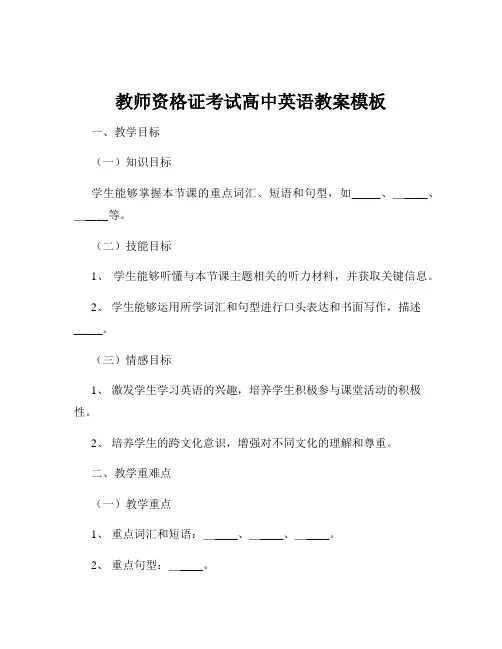
教师资格证考试高中英语教案模板一、教学目标(一)知识目标学生能够掌握本节课的重点词汇、短语和句型,如_____、_____、_____等。
(二)技能目标1、学生能够听懂与本节课主题相关的听力材料,并获取关键信息。
2、学生能够运用所学词汇和句型进行口头表达和书面写作,描述_____。
(三)情感目标1、激发学生学习英语的兴趣,培养学生积极参与课堂活动的积极性。
2、培养学生的跨文化意识,增强对不同文化的理解和尊重。
二、教学重难点(一)教学重点1、重点词汇和短语:_____、_____、_____。
2、重点句型:_____。
(二)教学难点1、如何引导学生正确运用所学词汇和句型进行口语和书面表达。
2、帮助学生理解和掌握某些复杂的语法结构,如_____。
三、教学方法(一)任务驱动法通过布置任务,让学生在完成任务的过程中学习和运用知识。
(二)情景教学法创设真实的语言情景,让学生在情景中感受和运用语言。
(三)合作学习法组织学生进行小组合作学习,培养学生的合作能力和交流能力。
四、教学过程(一)导入(Warmingup)通过播放一段与本节课主题相关的视频、歌曲或展示图片等方式,引起学生的兴趣,导入本节课的主题。
例如,展示一些世界各地著名的旅游景点的图片,然后提问学生:“Do you like traveling? Where do you want to go?”(二)呈现(Presentation)1、呈现新单词和短语利用图片、实物、动作等方式,直观地呈现本节课的重点单词和短语,如_____、_____、_____等,并带领学生跟读、拼写,帮助学生记忆。
2、呈现重点句型通过创设情景,引出重点句型,如_____。
然后,对句型进行结构分析和讲解,让学生理解句型的用法。
(三)练习(Practice)1、听力练习播放一段与本节课主题相关的听力材料,让学生听后回答问题,训练学生的听力理解能力。
2、口语练习组织学生进行小组讨论或角色扮演,运用所学的单词、短语和句型进行交流,提高学生的口语表达能力。
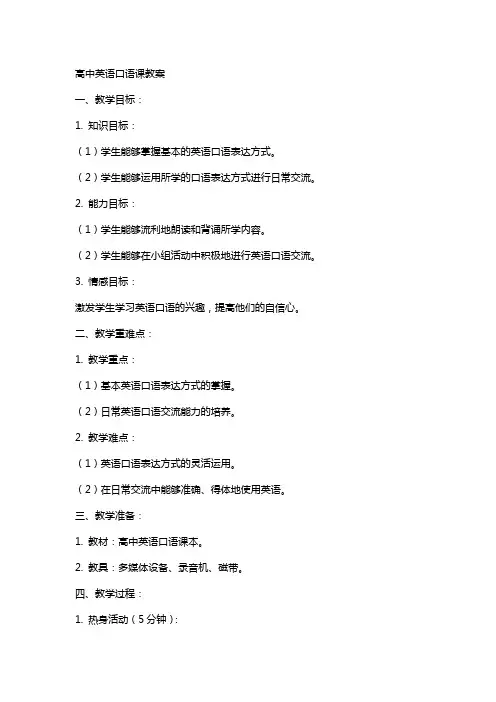
高中英语口语课教案一、教学目标:1. 知识目标:(1)学生能够掌握基本的英语口语表达方式。
(2)学生能够运用所学的口语表达方式进行日常交流。
2. 能力目标:(1)学生能够流利地朗读和背诵所学内容。
(2)学生能够在小组活动中积极地进行英语口语交流。
3. 情感目标:激发学生学习英语口语的兴趣,提高他们的自信心。
二、教学重难点:1. 教学重点:(1)基本英语口语表达方式的掌握。
(2)日常英语口语交流能力的培养。
2. 教学难点:(1)英语口语表达方式的灵活运用。
(2)在日常交流中能够准确、得体地使用英语。
三、教学准备:1. 教材:高中英语口语课本。
2. 教具:多媒体设备、录音机、磁带。
四、教学过程:1. 热身活动(5分钟):教师与学生进行简单的英语口语交流,提问学生关于日常生活的话题,引导学生积极参与。
2. 新课内容展示(15分钟):(1)教师引导学生学习新的口语表达方式,通过例句和情景演示,让学生理解并掌握这些表达方式。
(2)学生跟读并模仿,教师给予纠正和指导。
3. 小组活动(15分钟):学生分组,进行角色扮演,运用所学的口语表达方式进行交流。
教师巡回指导,纠正发音和表达错误。
4. 口语练习(10分钟):学生个体或小组为单位,进行口语练习,教师监听并给予评价。
五、作业设计:1. 抄写并背诵本节课所学的口语表达方式。
2. 结合所学内容,与同学进行英语口语交流,记录交流过程。
六、教学评价:1. 课堂表现评价:观察学生在课堂上的参与程度、口语表达的准确性和流畅性,以及小组活动中的合作态度。
2. 作业评价:检查学生作业的完成质量,包括口语表达的准确性和应用能力。
3. 口语测试:在课程结束后,组织一次口语测试,以评估学生对课程内容的掌握程度。
七、教学反思:在课程结束后,教师应进行教学反思,分析教学过程中的成功与不足,根据学生的反馈调整教学方法和内容,以便更有效地提高学生的英语口语能力。
八、课程拓展建议:1. 组织英语角活动,让学生在轻松的氛围中练习口语。
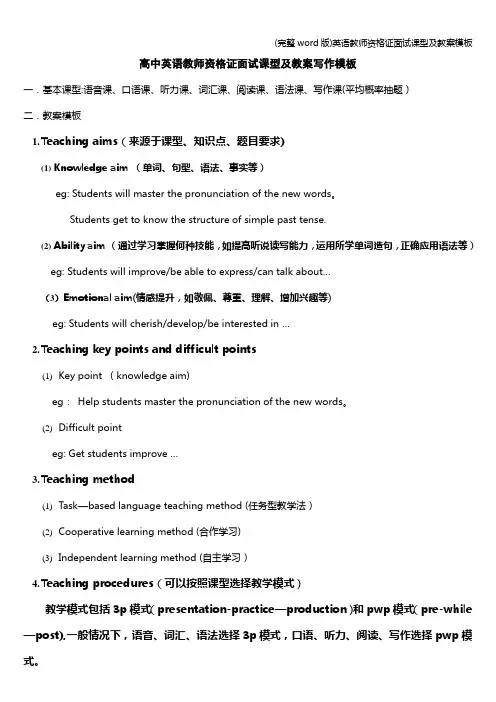
高中英语教师资格证面试课型及教案写作模板一.基本课型:语音课、口语课、听力课、词汇课、阅读课、语法课、写作课(平均概率抽题)二.教案模板1.Teaching aims(来源于课型、知识点、题目要求)(1)Knowledge aim (单词、句型、语法、事实等)eg: Students will master the pronunciation of the new words。
Students get to know the structure of simple past tense.(2)Ability aim (通过学习掌握何种技能,如提高听说读写能力,运用所学单词造句,正确应用语法等)eg: Students will improve/be able to express/can talk about…(3)Emotional aim(情感提升,如敬佩、尊重、理解、增加兴趣等)eg: Students will cherish/develop/be interested in …2.Teaching key points and difficult points(1)Key point (knowledge aim)eg:Help students master the pronunciation of the new words。
(2)Difficult pointeg: Get students improve …3.Teaching method(1)Task—based language teaching method (任务型教学法)(2)Cooperative learning method (合作学习)(3)Independent learning method (自主学习)4.Teaching procedures(可以按照课型选择教学模式)教学模式包括3p模式(presentation-practice—production)和pwp模式(pre-while —post),一般情况下,语音、词汇、语法选择3p模式,口语、听力、阅读、写作选择pwp模式。
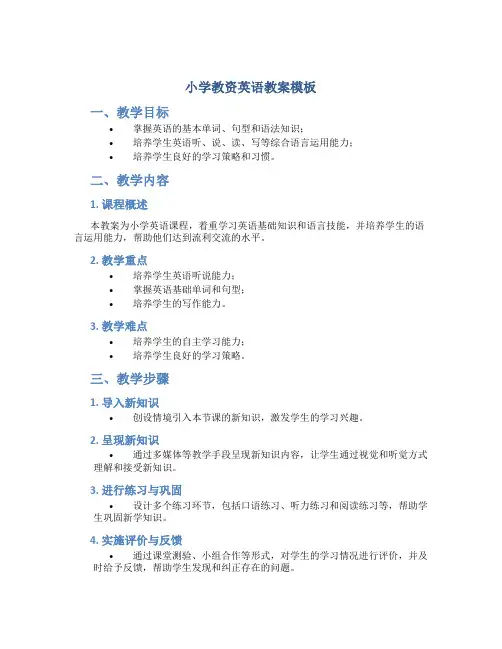
小学教资英语教案模板一、教学目标•掌握英语的基本单词、句型和语法知识;•培养学生英语听、说、读、写等综合语言运用能力;•培养学生良好的学习策略和习惯。
二、教学内容1. 课程概述本教案为小学英语课程,着重学习英语基础知识和语言技能,并培养学生的语言运用能力,帮助他们达到流利交流的水平。
2. 教学重点•培养学生英语听说能力;•掌握英语基础单词和句型;•培养学生的写作能力。
3. 教学难点•培养学生的自主学习能力;•培养学生良好的学习策略。
三、教学步骤1. 导入新知识•创设情境引入本节课的新知识,激发学生的学习兴趣。
2. 呈现新知识•通过多媒体等教学手段呈现新知识内容,让学生通过视觉和听觉方式理解和接受新知识。
3. 进行练习与巩固•设计多个练习环节,包括口语练习、听力练习和阅读练习等,帮助学生巩固新学知识。
4. 实施评价与反馈•通过课堂测验、小组合作等形式,对学生的学习情况进行评价,并及时给予反馈,帮助学生发现和纠正存在的问题。
四、教学手段•多媒体设备(电视、投影仪等)•教学课件•教学用具(单词卡片、图片卡片等)五、教学资源•课本资料•教学课件•多媒体设备六、教学评价•学生的课堂表现(包括参与度、发言情况等)•学生的课后作业完成情况•学生的考试成绩七、教学反思本节课通过合理的教学设计和选用多种教学手段,激发了学生的学习兴趣,提高了他们的学习兴趣,提高了他们的学习效果。
但在教学过程中,仍需进一步关注学生的学习巩固情况,并更注重学生的个性化学习需求,以满足不同学生的学习需求。
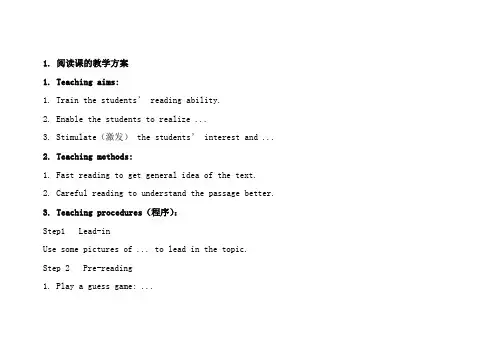
1. 阅读课的教学方案1. Teaching aims:1. Train the students’ reading ability.2. Enable the students to realize ...3. Stimulate(激发) the students’ interest and ...2. Teaching methods:1. Fast reading to get general idea of the text.2. Careful reading to understand the passage better.3. Teaching procedures(程序):Step1 Lead-inUse some pictures of ... to lead in the topic.Step 2 Pre-reading1. Play a guess game: ...2. Play another guess game: ...Step 3 Predict(预测)1. Ask the students to predict what the reading passage talks about according to the title and illustrations(插图) of passage. The teacher can give some clues by talking about the illustrations: ......Step 4 Skimming(略读)1. Let the students skim the whole passage to get the main idea, then evaluate their predictions. During this activity, the teacher should give some guidance(指导) on reading skills.Main idea of the passage:...2. Let the students skim the passage and divide it into different parts to find out the main idea of every part an the topic sentences.Part 1 (paragraph 1...)......Step 5 Careful reading... (问题)Ask the students to scan the second part and complete the chart(图表)with information from the passage.Ask the students to read carefully and finish the following tasks:......(设计一些问题或判断对错等)2. 听说课的教学方案:Knowledge aims1. To listen to and understand the listening materials.2. Students can master the following expressions:...(一些句型)Ability aims1. Enable students to catch and understand the listening materials.2. Develop students’ ability to get special information and take note while listening.3. Get students to learn and use the expressions of ...Emotional aim1. Enable students to know more about ...2. Develop students’ sense of ...Teaching proceduresStep 1 Lead-inPlay a game ...1. Put students into pairs. Give them each two minutes to think of ......(游戏过程)Step 2 Pre-listening1. Tell students they will listen to a dialogue about ...2. Give students some directions and make them predict what the listening text is about.Step 3 While-listening1. Tell students listen to the tape first to get the main idea and decide whether their predictiongist right or not.2. Ask students to listen to the tape again. Let them listen and answer some questions. (Show the questions on the blackboard)3. Students exchange the information and listen to the tape a third time for checking. Let them have the correct answers.Step 4 Post-listening1. Give 2-3 minutes to students to ask questions if they have any.2. Show students the listening text and let them read it aloud.3. Let students read aloud the questions and expressions on the blackboard:...(之前目标里的句型)4. Make sure they will understand and enable to use the, Then let them in Pairs discuss ...5. Get some pairs to act out their dialogue in front of the class.Step 5 Homework1. Make sentences with the expressions in the lesson.2. Surf the internet to find out more information about ...3. 给一篇文章用来讲语法的课堂设计Knowledge objectivesTo learn the use of ... (语法点)Ability objectivesTo use ... (语法) correctly and properly according to the context. Emotional objectives1. To become interested in grammar learning.2. To develop the sense of group cooperationTeaching important pointsGet students to learn and master the new grammar item: ... (语法)Teaching difficult pointsEnable students to learn how to use ... correctly.Teaching proceduresStep 1 Revision1. Check the homework exercises.2. Let students dictate some new words and expressions.Step 2 Discovering useful structures1. Ask students to read through the passage ... , pick out the sentences where ...(语法) are, and then underline ... (语法)2. Let students work in pairs to translate these sentences and try to understand the use of ...3. Have students observe the sentences and draw the conclusion: ...Step 3 Understanding and summarizing1. Ask students to work in pairs to finish the following exercises on how ... are used. (Show the following on the screen)...Step 4 Using structures(Show the following exercises on the screen or give out exercises papers.)Answer the following questions using ......1. Ask students to work in group of four.2. Give them four minutes to finish the work and ask each group to choose the best answers.3. Ask students to choose the best sentences.Step 5 Playing the gameGet into groups and play the game:Step 6 Closing down by a quiz.(Show some exercises on the screen.)Let students finish them within a few minutes, then check the answers with the whole class.4. 写作课的教学方案Knowledge objectivesBy the end of this lesson the students:1. will have a better understanding of the structure and characteristics of an advertisement.2. will grasp some useful words and expressions to describe a good restaurant such as: ... Ability objectives1. To grasp the use of persuasive sentences.2. To improve the ability of in gathering, analyzing, comparing and making conclusion.Moral objectives1. To improve the students’ learning motivation.2. To make the students become confident.3. To improve their ability of cooperating with each other through discussing.Teaching important and difficult pointsTask-based approach, cooperating approach and communicative approach.Teaching proceduresStep 1 Revision & lead inFirst check the homework of last class.Then let the students swap the homework with each other and discuss in groups of 4, take notes, find out and category the impressive sentences into 5 kinds of information:...Step 2 Discussing1. Show students 4 pictures of ...2. Ask 3 students to report their work, show them the pictures of ...Step 3 Pre-writing1. Show them the sample ...2. Read the ... and think over what are the characteristics of ... , encourage some students to analyze and tell their opinion.Step 4 While-writing1. Ask students to read the requirements on the text.2. Ask them to write the topic sentence first, and then write at least 6 supporting sentences to ... Step 5 Post-writingLet them swap their passage with each other and recommend 3 most successful ...Step 6 Homework1. Polish students’ writing and write some more aspects of ...Their final work will be modifiedand selected, then the most successful ones will be put up on the English Corner.2. Review the words and expressions in this unit.5. 阅读课的教学方案Teaching aims1. To know the meaning and usage of the following words: ...To understand some important sentences in the text and know the structure and usage of inversion.2. To master the micro-reading skills through skimming and scanning.3. To know the ability and knowledge ... and develop the ability of getting information from the passage and dealing with the information.Teaching methodsTask-based learning; situational learning; group work learning.The key and difficult points1. To enable the students to get the main idea of the passage, analyze the structure, and get useful information.2. To train the students of micro-reading skills such as skimming and scanning, and develop their ability of reorganizing and transferring information.Teaching processStep 1 Pre-readingQuestion:Step 2 SkimmingQuestions( To explain some words and structures.)Step 3 Detailed readingStep 4 InterviewStep 5 SummaryStep 6 Homework1. Read and practice the dialogue after class fluently.2. Find the useful words and expressions in the passage and do exercises on the textbook following the passage to consolidate them.1. 阅读课的教学方案1. Teaching aims:1. Train the students’ reading ability.2. Enable the students to realize ...3. Stimulate(激发) the students’ interest and ...2. Teaching methods:1. Fast reading to get general idea of the text.2. Careful reading to understand the passage better.3. Teaching procedures(程序):Step1 Lead-inUse some pictures of ... to lead in the topic.Step 2 Pre-reading1. Play a guess game: ...2. Play another guess game: ...Step 3 Predict(预测)1. Ask the students to predict what the reading passage talks about according to the title and illustrations(插图) of passage. The teacher can give some clues by talking about the illustrations: ......Step 4 Skimming(略读)1. Let the students skim the whole passage to get the main idea, then evaluate their predictions. During this activity, the teacher should give some guidance(指导) on reading skills.Main idea of the passage:...2. Let the students skim the passage and divide it into different parts to find out the main idea of every part an the topic sentences.Part 1 (paragraph 1...)......Step 5 Careful reading... (问题)Ask the students to scan the second part and complete the chart(图表)with information from the passage.Ask the students to read carefully and finish the following tasks: ......(设计一些问题或判断对错等)2. 听说课的教学方案:Knowledge aims1. To listen to and understand the listening materials.2. Students can master the following expressions:...(一些句型)Ability aims1. Enable students to catch and understand the listening materials.2. Develop students’ ability to get special information and take note while listening.3. Get students to learn and use the expressions of ...Emotional aim1. Enable students to know more about ...2. Develop students’ sense of ...Teaching proceduresStep 1 Lead-inPlay a game ...1. Put students into pairs. Give them each two minutes to think of ......(游戏过程)Step 2 Pre-listening1. Tell students they will listen to a dialogue about ...2. Give students some directions and make them predict what the listening text is about.Step 3 While-listening1. Tell students listen to the tape first to get the main idea and decide whether their prediction gist right or not.2. Ask students to listen to the tape again. Let them listen and answer some questions. (Show the questions on the blackboard)3. Students exchange the information and listen to the tape a third time for checking. Let them have the correct answers.Step 4 Post-listening1. Give 2-3 minutes to students to ask questions if they have any.2. Show students the listening text and let them read it aloud.3. Let students read aloud the questions and expressions on the blackboard:...(之前目标里的句型)4. Make sure they will understand and enable to use the, Then let them in Pairs discuss ...5. Get some pairs to act out their dialogue in front of the class.Step 5 Homework1. Make sentences with the expressions in the lesson.2. Surf the internet to find out more information about ...3. 给一篇文章用来讲语法的课堂设计Knowledge objectivesTo learn the use of ... (语法点)Ability objectivesTo use ... (语法) correctly and properly according to the context. Emotional objectives1. To become interested in grammar learning.2. To develop the sense of group cooperationTeaching important pointsGet students to learn and master the new grammar item: ... (语法)Teaching difficult pointsEnable students to learn how to use ... correctly.Teaching proceduresStep 1 Revision1. Check the homework exercises.2. Let students dictate some new words and expressions.Step 2 Discovering useful structures1. Ask students to read through the passage ... , pick out the sentences where ...(语法) are, and then underline ... (语法)2. Let students work in pairs to translate these sentences and try to understand the use of ...3. Have students observe the sentences and draw the conclusion: ...Step 3 Understanding and summarizing1. Ask students to work in pairs to finish the following exercises on how ... are used. (Show the following on the screen)...Step 4 Using structures(Show the following exercises on the screen or give out exercises papers.)Answer the following questions using ......1. Ask students to work in group of four.2. Give them four minutes to finish the work and ask each group to choose the best answers.3. Ask students to choose the best sentences.Step 5 Playing the gameGet into groups and play the game:Step 6 Closing down by a quiz.(Show some exercises on the screen.)Let students finish them within a few minutes, then check the answers with the whole class.4. 写作课的教学方案Knowledge objectivesBy the end of this lesson the students:1. will have a better understanding of the structure and characteristics of an advertisement.2. will grasp some useful words and expressions to describe a good restaurant such as: ... Ability objectives1. To grasp the use of persuasive sentences.2. To improve the ability of in gathering, analyzing, comparing and making conclusion.Moral objectives1. To improve the students’ learning motivation.2. To make the students become confident.3. To improve their ability of cooperating with each other through discussing.Teaching important and difficult pointsTask-based approach, cooperating approach and communicative approach.Teaching proceduresStep 1 Revision & lead inFirst check the homework of last class.Then let the students swap the homework with each other and discuss in groups of 4, take notes, find out and category the impressive sentences into 5 kinds of information:...Step 2 Discussing1. Show students 4 pictures of ...2. Ask 3 students to report their work, show them the pictures of ...Step 3 Pre-writing1. Show them the sample ...2. Read the ... and think over what are the characteristics of ... , encourage some students to analyze and tell their opinion.Step 4 While-writing1. Ask students to read the requirements on the text.2. Ask them to write the topic sentence first, and then write at least 6 supporting sentences to ... Step 5 Post-writingLet them swap their passage with each other and recommend 3 most successful ...Step 6 Homework1. Polish students’ writing and write some more aspects of ...Their final work will be modified and selected, then the most successful ones will be put up on the English Corner.2. Review the words and expressions in this unit.5. 阅读课的教学方案Teaching aims1. To know the meaning and usage of the following words: ...To understand some important sentences in the text and know the structure and usage of inversion.2. To master the micro-reading skills through skimming and scanning.3. To know the ability and knowledge ... and develop the ability of getting information from the passage and dealing with the information.Teaching methodsTask-based learning; situational learning; group work learning.The key and difficult points1. To enable the students to get the main idea of the passage, analyze the structure, and get useful information.2. To train the students of micro-reading skills such as skimming and scanning, and develop their ability of reorganizing and transferring information.Teaching processStep 1 Pre-readingQuestion:Step 2 SkimmingQuestions( To explain some words and structures.)Step 3 Detailed readingStep 4 InterviewStep 5 SummaryStep 6 Homework1. Read and practice the dialogue after class fluently.2. Find the useful words and expressions in the passage and do exercises on the textbook following the passage to consolidate them.制定学习目标的三个原则——适当、明确、具体人生在世,谁都希望获得成功,而世界公认的成功定义是:成功就是逐步实现一个有意义的既定目标。
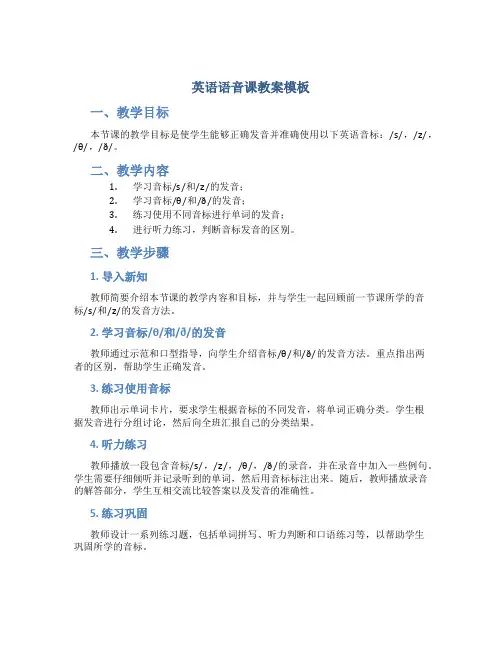
英语语音课教案模板一、教学目标本节课的教学目标是使学生能够正确发音并准确使用以下英语音标:/s/,/z/,/θ/,/ð/。
二、教学内容1.学习音标/s/和/z/的发音;2.学习音标/θ/和/ð/的发音;3.练习使用不同音标进行单词的发音;4.进行听力练习,判断音标发音的区别。
三、教学步骤1. 导入新知教师简要介绍本节课的教学内容和目标,并与学生一起回顾前一节课所学的音标/s/和/z/的发音方法。
2. 学习音标/θ/和/ð/的发音教师通过示范和口型指导,向学生介绍音标/θ/和/ð/的发音方法。
重点指出两者的区别,帮助学生正确发音。
3. 练习使用音标教师出示单词卡片,要求学生根据音标的不同发音,将单词正确分类。
学生根据发音进行分组讨论,然后向全班汇报自己的分类结果。
4. 听力练习教师播放一段包含音标/s/,/z/,/θ/,/ð/的录音,并在录音中加入一些例句。
学生需要仔细倾听并记录听到的单词,然后用音标标注出来。
随后,教师播放录音的解答部分,学生互相交流比较答案以及发音的准确性。
5. 练习巩固教师设计一系列练习题,包括单词拼写、听力判断和口语练习等,以帮助学生巩固所学的音标。
6. 小结与作业布置教师对本节课的学习内容进行小结,并布置相关的作业。
作业包括完成课后练习册上的相关练习,以及收集并整理更多包含音标/θ/和/ð/的单词和例句。
四、教学资源1.相关单词卡片;2.录音机或电脑播放设备;3.课后练习册。
五、教学评估教师将通过学生在课堂练习和作业中的表现来评估他们对本节课所学内容的掌握情况。
同时,教师还将通过观察学生在练习中的发音准确性和听力理解能力来评估他们的学习进展。
六、教学延伸为了进一步巩固和提高学生对音标的掌握,教师可以引导学生进行更多的口语练习,并提供更多的听力材料和相关学习资源供学生自主学习和拓展。
七、教学反思通过本节课的教学实践,发现学生对音标/θ/和/ð/的发音有一定的困惑,建议在接下来的教学中加强针对这两个音标的练习和强调。
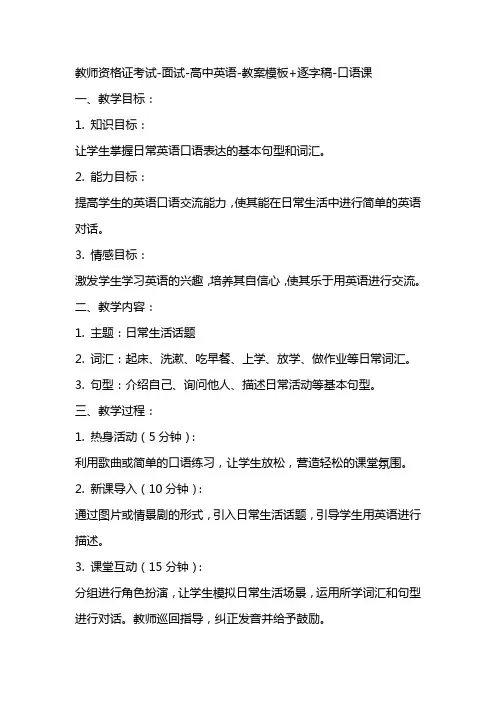
教师资格证考试-面试-高中英语-教案模板+逐字稿-口语课一、教学目标:1. 知识目标:让学生掌握日常英语口语表达的基本句型和词汇。
2. 能力目标:提高学生的英语口语交流能力,使其能在日常生活中进行简单的英语对话。
3. 情感目标:激发学生学习英语的兴趣,培养其自信心,使其乐于用英语进行交流。
二、教学内容:1. 主题:日常生活话题2. 词汇:起床、洗漱、吃早餐、上学、放学、做作业等日常词汇。
3. 句型:介绍自己、询问他人、描述日常活动等基本句型。
三、教学过程:1. 热身活动(5分钟):利用歌曲或简单的口语练习,让学生放松,营造轻松的课堂氛围。
2. 新课导入(10分钟):通过图片或情景剧的形式,引入日常生活话题,引导学生用英语进行描述。
3. 课堂互动(15分钟):分组进行角色扮演,让学生模拟日常生活场景,运用所学词汇和句型进行对话。
教师巡回指导,纠正发音并给予鼓励。
4. 巩固练习(10分钟):设计一些简单的口语问答游戏,让学生在游戏中进一步巩固所学内容。
5. 总结与作业(5分钟):对本节课所学内容进行总结,布置相关的口语作业,要求学生课后进行练习。
四、教学评价:1. 课堂表现:观察学生在课堂上的参与程度、发音准确性以及口语表达流畅性。
2. 作业完成情况:检查学生课后口语作业的完成质量,对发音和表达进行评价。
3. 小组活动表现:评估学生在小组角色扮演中的表现,关注其与合作者的互动交流。
五、教学资源:1. 图片素材:日常生活场景的图片,如起床、洗漱、吃早餐等。
2. 音频素材:英语口语练习的歌曲或对话音频。
3. 教学卡片:用于课堂游戏和角色扮演的卡片。
4. 作业模板:课后口语作业的模板,包括发音和表达要求。
注意事项:1. 针对不同水平的学生,可以适当调整教学内容和难度。
2. 在课堂互动环节,鼓励学生大胆开口说英语,给予充分的时间进行练习。
4. 课后作业的布置要具有针对性和实用性,让学生能够在生活中运用所学知识。
教师资格证英语教案模板一、教学目标:1. 知识目标,学生能够掌握本节课的重点单词和短语,理解并运用本课的语法知识。
2. 能力目标,学生能够通过本节课的学习,提高自己的听、说、读、写能力,能够进行简单的英语交流。
3. 情感目标,培养学生对英语学习的兴趣,激发学生学习英语的积极性。
二、教学重点和难点:1. 重点,本节课的重点是单词和短语的掌握,以及语法知识的运用。
2. 难点,学生对于一些抽象的语法知识的理解和运用可能存在一定的难度。
三、教学过程:1. 热身活动(Warm-up),通过播放一段英文歌曲,让学生在欢快的音乐中放松自己,为接下来的学习做好准备。
2. 学习新知识(Presentation),教师通过图片、实物等教具向学生展示本节课的重点单词和短语,并讲解相关的语法知识。
3. 听力训练(Listening),播放录音,让学生听懂并标出所听到的单词和短语,培养学生的听力能力。
4. 口语练习(Speaking),教师设计一些情景对话,让学生进行角色扮演,提高学生的口语表达能力。
5. 阅读训练(Reading),让学生阅读相关的短文或对话,理解其中的内容,并进行相关的练习。
6. 书写练习(Writing),让学生进行相关的书写练习,巩固所学的单词和短语,并运用到实际的句子中。
7. 课堂小结(Summary),教师对本节课的重点内容进行总结,并对学生的学习情况进行评价和反馈。
四、教学手段:1. 多媒体教学,通过投影仪、录音机等多媒体设备,让学生更直观地了解所学内容。
2. 教具,教师准备相关的图片、实物等教具,让学生通过视觉和触觉更好地理解所学内容。
3. 角色扮演,通过情景对话等形式,让学生更好地进行口语练习。
五、教学反思:通过本节课的教学,学生的学习兴趣得到了激发,能够主动参与课堂活动;学生的英语听、说、读、写能力得到了一定的提高,但在语法知识的理解和运用上还存在一定的难度,需要在后续的教学中加强相关的训练。
2024年教师资格证小学英语面试教案模板汇总一、教案模板一:《Hello!》【教学目标】1.让学生能够听懂、会说“Hello!”这个问候语。
2.培养学生用英语进行简单交流的能力。
3.增加学生对英语学习的兴趣。
【教学重难点】重点:学会说“Hello!”难点:正确发音和运用“Hello!”【教学准备】1.图片或卡片2.课件或黑板3.录音机或音响【教学过程】Step1:导入教师展示一张图片,让学生猜测图片中的人物在做什么。
Step2:新课展示教师展示“Hello!”这个单词,并用中文解释其含义。
教师播放录音,让学生听并模仿发音。
教师引导学生用“Hello!”互相问候。
Step3:操练教师设计一些情景,让学生在不同的场景中运用“Hello!”。
学生分组练习,互相问候。
Step4:小组活动教师将学生分成小组,每组选出一个代表,代表用“Hello!”问候其他小组的成员。
每个小组轮流进行,直到所有学生都参与。
布置作业:让学生回家后,用“Hello!”向家人问候。
二、教案模板二:《Ilikeapples》【教学目标】1.让学生能够听懂、会说“Ilikeapples”这个句子。
2.培养学生用英语描述自己喜欢的食物。
3.增加学生对英语学习的兴趣。
【教学重难点】重点:学会说“Ilikeapples”这个句子。
难点:正确发音和运用“Ilikeapples”。
【教学准备】1.图片或卡片2.课件或黑板3.录音机或音响【教学过程】Step1:导入教师展示一张苹果的图片,引导学生用中文描述苹果。
教师用英语说“Ilikeapples”,让学生猜测其含义。
Step2:新课展示教师展示“Ilikeapples”这个句子,并用中文解释其含义。
教师播放录音,让学生听并模仿发音。
教师引导学生用“Ilikeapples”描述自己喜欢的食物。
Step3:操练教师设计一些情景,让学生在不同的场景中运用“Ilikeapples”。
学生分组练习,互相描述自己喜欢的食物。
教师资格证考试英语教案模板及范文全文共3篇示例,供读者参考篇1Title: English Lesson Plan Template and ModelIntroductionAs a student preparing for the Teacher Qualification Examination, having a solid understanding of how to create effective English lesson plans is crucial. A well-structured lesson plan serves as a roadmap for teachers, ensuring that lessons are organized, engaging, and aligned with learning objectives. In this document, I will provide a comprehensive template and a model lesson plan to help aspiring teachers like myself develop their skills in lesson planning.Lesson Plan TemplateLesson OverviewGrade Level/Course:Topic/Unit:Lesson Title:Time Required:Learning ObjectivesBy the end of the lesson, students will be able to:Objective 1Objective 2Objective 3Materials and ResourcesList of required materials (textbooks, handouts, multimedia resources, etc.)Warm-up/HookDescribe an attention-grabbing activity or prompt to engage students and introduce the lesson topic.Introduction/ReviewBriefly review relevant prior knowledge or skills necessary for the lesson.Establish connections to previous lessons or real-life applications.Presentation/ModelingOutline the step-by-step process for presenting new information, concepts, or skills.Describe how you will model or demonstrate the desired knowledge or skills.Guided PracticePlan activities or exercises that allow students to practice the new knowledge or skills with your guidance and support.Independent PracticeProvide opportunities for students to apply their learning independently, either in class or as homework assignments.Formative AssessmentDescribe how you will assess students' understanding and mastery of the lesson objectives (e.g., questioning, exit tickets, quizzes).ClosureSummarize the key points and reinforce the main ideas of the lesson.Provide a preview or transition to the next lesson or unit.Differentiation and AccommodationsOutline strategies for addressing diverse learning needs, abilities, and styles.Describe modifications or accommodations for students with special needs or English language learners.Extension/Enrichment ActivitiesSuggest additional activities or resources for students who require further challenge or enrichment.Model Lesson Plan: Introduction to Descriptive WritingLesson OverviewGrade Level/Course: 6th Grade EnglishTopic/Unit: Writing SkillsLesson Title: Introduction to Descriptive WritingTime Required: 60 minutesLearning ObjectivesBy the end of the lesson, students will be able to:Understand the purpose and characteristics of descriptive writing.Identify and use sensory details to create vivid descriptions.Write a descriptive paragraph about a chosen object or scene.Materials and ResourcesWhiteboard or projectorSample descriptive writing passagesDescriptive writing handoutWriting materials (paper and pencils/pens)Warm-up/HookDisplay a vivid image or object (e.g., a seashell, a piece of fruit) and ask students to describe it using their senses (sight, smell, touch, etc.).Introduction/ReviewReview the different types of writing (narrative, expository, persuasive, descriptive).Explain the purpose of descriptive writing: to create a clear and vivid picture in the reader's mind using sensory details.Presentation/ModelingShare examples of descriptive writing passages and analyze the use of sensory details.Model the process of writing a descriptive paragraph by describing a familiar object or scene, emphasizing the use of sensory details.Guided PracticeProvide students with a descriptive writing handout containing prompts or objects to describe.Guide students through the process of generating sensory details and organizing them into descriptive paragraphs.Encourage students to share their descriptive paragraphs and provide feedback.Independent PracticeAssign students to choose a specific object or scene (e.g., a favorite place, a memorable experience) and write a descriptive paragraph incorporating sensory details.Formative AssessmentCirculate and observe students during independent practice, providing feedback and guidance as needed.Collect and review the descriptive paragraphs for understanding and application of the lesson objectives.ClosureHave students share their descriptive paragraphs with the class or in small groups.Summarize the key elements of effective descriptive writing and its importance in engaging readers.Differentiation and AccommodationsProvide sentence starters or word banks for struggling writers.Offer alternative means of expression (e.g., drawing, recording) for students with specific learning needs.Pair or group students with varying abilities to support peer learning.Extension/Enrichment ActivitiesChallenge advanced students to incorporate figurative language (e.g., similes, metaphors) into their descriptive writing.Encourage students to expand their descriptive paragraphs into longer narrative or expository pieces.Provide additional descriptive writing prompts or resources for further practice.ConclusionThis lesson plan template and model provide a comprehensive guide for aspiring English teachers to create engaging and effective lessons. By following the template and studying the model lesson plan, students can develop their lesson planning skills and gain confidence in their ability to deliver well-structured and meaningful English lessons.篇2Teacher Certification Exam: English Lesson Plan Template and ModelLesson Plan TemplateTitle: [Lesson title]Grade Level: [Grade level(s) the lesson is intended for]Duration: [Approximate length of the lesson in minutes]Objectives:[List out 2-3 specific, measurable objectives students should be able to achieve by the end of the lesson]Materials Needed:[List all materials the teacher and students will need, e.g. textbooks, handouts, technology, etc.]Warm-up (5-10 mins):[Describe the opening activity to capture students' interest and activate prior knowledge]Introduction to New Material (10-15 mins):[Outline how the new concepts/skills will be presented to students through explanation, modeling, visuals, etc.]Guided Practice (15-20 mins):[Plan activities that allow students to apply the new learning with teacher guidance and feedback]Independent Practice (15-20 mins):[Design tasks for students to practice applying the new skills/concepts independently]Closing (5-10 mins):[Describe how you will summarize key points and assess whether objectives were met]Homework/Extension:[Suggest homework assignments or additional practice to reinforce and extend the learning]Model Lesson PlanTitle: Analyzing Persuasive Techniques in AdvertisementsGrade Level: 9th GradeDuration: 55 minutesObjectives:Students will be able to identify and analyze persuasive techniques used in advertisements.Students will be able to evaluate the effectiveness of persuasive techniques used.Students will be able to create an original persuasive advertisement using appropriate techniques.Materials Needed:Projector and examples of print/video advertisementsPersuasive Techniques handoutAdvertisement Analysis worksheetWarm-up (5 mins):Students discuss in pairs what techniques companies use to persuade consumers to buy products based on their prior knowledge and experience.Introduction to New Material (15 mins):Teacher presents the "Persuasive Techniques" handout listing techniques like repetition, loaded language, appeal to emotions, etc. with explanations and examples.As a class, analyze 2-3 example advertisements (print or video) and identify the persuasive techniques used.Guided Practice (15 mins):Students get into small groups and are given 2 different advertisements to analyze.Using the Advertisement Analysis worksheet, they identify the persuasive techniques used and evaluate their effectiveness.Groups share findings and teacher provides feedback.Independent Practice (15 mins):Students work individually to create an original print advertisement for a make-believe product using at least 4 different persuasive techniques from the handout.They write an explanation defending their choice of persuasive techniques.Closing (5 mins):Few students volunteer to briefly present their advertisement and share the persuasive techniques used. Teacher assesses if objectives were met based on students' examples and understanding demonstrated.Homework/Extension:Bring in 2-3 examples of advertisements from various media and analyze the persuasive techniques used for homework. For extension, create a persuasive video advertisement script for the make-believe product from class using visual and audio persuasive techniques.篇3Teacher Certification English Exam Lesson Plan TemplateTitle: [Lesson Title]Grade Level: [Grade level the lesson is intended for]Language Skills: [The language skills the lesson will cover, e.g. reading, writing, listening, speaking]Lesson Objectives:[List out 3-5 specific, measurable objectives stating what students will be able to do by the end of the lesson]Materials Needed:[List all materials the teacher and students will need, e.g. textbooks, handouts, technology, etc.]Warm-Up (5-10 minutes):[Describe a short activity to introduction the lesson topic and activate prior knowledge]Presentation (10-15 minutes):[Outline how the key content/language points will be presented, e.g. lecture, discussion, video, reading, etc.]Guided Practice (15-20 minutes):[Describe an activity where students will practice using the new information/skills from the presentation with guidance and modeling from the teacher]Independent Practice (15-20 minutes):[An activity allowing students to practice independently to reinforce and extend their learning]Evaluation/Assessment:[How you will evaluate if students met the lesson objectives, e.g. exit ticket, project, quiz, observation, etc.]Wrap-Up (5 minutes):[How you will summarize and conclude the lesson]Example Lesson Plan: Persuasive WritingTitle: Persuasive Writing with Contemporary IssuesGrade Level: 10th GradeLanguage Skills: Writing, Reading, SpeakingLesson Objectives:Students will be able to...Identify characteristics of persuasive writingAnalyze persuasive techniques used in examplesWrite a well-structured persuasive essay using relevant evidenceMaterials Needed:Persuasive writing examples (print or digital)Persuasive essay rubricLaptops/chromebooks for writingWarm-Up (7 mins): Students discuss opinions on a controversial topic like dress codes or cell phone policies and what side they support.Presentation (12 mins):Teacher presents powerpoint on persuasive writing techniques like:Stating a clear claim/positionLogical reasoning and evidenceAddressing counter-argumentsRhetorical strategies (pathos, logos, ethos)Strong conclusionGuided Practice (18 mins):As a class, analyze a few brief examples of persuasive writing (editorials, speeches, etc.). Identify the claim, evidence, rhetorical techniques, and strengths/weaknesses.Independent Practice (20 mins):Students choose a contemporary issue (environment, social media, school policies, etc.) and begin drafting a persuasive essay, applying the techniques from the lesson.Evaluation:Persuasive essay drafts assessed with a rubric on criteria like:Clear, precise claimRelevant supporting evidenceAddressing counter-argumentsOrganization and focusGrammar, style, conventionsWrap-Up (3 mins):Students share their chosen issue/claim and one persuasive technique they plan to use. Remind of upcoming due date for final draft.。
教资笔试英语教案模板教资面试初中英语教案【篇1:2021教师资格面试指导初中英语听说课】教师资格面试指导——初中英语听说课随着教师资格证考试的全国统考化,考试难度也随之增加,尤其是教师资格证考试中的面试环节(以下简称教资面试)。
这无形中也给考生带来了诸多压力,想要考取初中英语教师资格证,就必须要过试讲这一关。
在教资面试的初中英语试讲中,考生可能会抽到多种类型的试讲题目。
如果考生抽到的题目中有以下类似要求,则可以将其设计为一堂听说课:1.重点练习学生听说的能力;2.要求学生展示对话;3.设计听后的口语活动。
今天我们先来谈一谈如何设计初中英语的听说课。
听说是学习英语所需要培养的技能,因此在技能教学中,我们最常用的方式就是pwp模式(pre-listening,while-listening,post-listening)。
那么在这个pwp模式的每个环节中,我们具体要根据什么来设计课堂环节呢?根据义务教育阶段的英语课程标准,我们总结出,在听前阶段我们主要是以熟悉相关词语和句型、提出需要解决的问题为目的、和明确具体任务为目的来设计教学活动;在听中阶段,则以听信息,排顺序、列项目、补全文字等完成各种任务为目的;在听后阶段,也就是练习说的环节,设计的教学活动应以口头回答问题、模拟或表演情景对话、小组讨论等形式来展开。
因此考生在设计课堂活动时,要紧紧围绕以上的关键信息设计听说课。
可以将听说课的流程设计为以下几步:导入,听前,听中,听后,小结作业。
首先我们从课堂导入开始说起。
初中英语教学最常用的导入方式有两种,一个是温故知新导入法(以复习、提问、表演上节课学过的对话等开始,向学生提供新、旧知识联系的要点),一个是设置情景导入法(指综合利用图片、音乐、视频等设备,结合教师语言、学生活动等因素,制造出一种符合教学需要的情景的导入方法)。
一般来讲,在面试中为了吸引考官的眼球,建议考生采用设置情景导入方式。
设置情景导入方式又可以分为以下几种:实物导入法、游戏导入法、创疑导入法、音视频导入法、生活实例导入法、人物故事导入法、名言名句、活动表演导入法等。
英语教资教案模板初中一、教学目标1. 知识目标(1)能够理解并掌握本课的主要词汇和短语。
(2)能够正确运用本课所学的句型进行简单的交流。
(3)能够听懂、说懂、读懂本课的内容。
2. 能力目标(1)能够通过阅读、听力等方式获取信息,并能够进行简单的信息处理。
(2)能够通过听、说、读、写等方式表达自己的观点和感受。
3. 情感目标(1)能够积极参与课堂活动,与老师和同学进行良好的互动。
(2)能够培养对英语学习的兴趣和自信心。
二、教学内容1. 主要词汇和短语(1)列出本课的主要词汇和短语。
(2)通过图片、例句等方式帮助学生理解和记忆词汇和短语。
2. 主要句型(1)介绍本课的主要句型。
(2)通过例句、练习等方式帮助学生理解和运用句型。
3. 课文内容(1)介绍本课的课文内容。
(2)通过阅读、讨论等方式帮助学生理解和掌握课文内容。
三、教学步骤1. 导入(1)通过图片、问题等方式引起学生的兴趣,导入新课。
2. 呈现(1)通过图片、实物等方式呈现本课的主要词汇和短语。
(2)通过例句、练习等方式呈现本课的主要句型。
3. 练习(1)通过小组活动、游戏等方式让学生进行词汇和句型的练习。
4. 阅读(1)让学生阅读课文,理解课文内容。
(2)通过问题、讨论等方式帮助学生理解课文内容。
5. 输出(1)通过角色扮演、写作等方式让学生运用所学知识进行输出。
6. 总结(1)对本课的主要内容进行总结。
(2)布置作业,让学生进行巩固练习。
四、教学评价1. 课堂参与度(1)观察学生在课堂活动中的参与情况,是否积极回答问题,与同学进行互动。
2. 知识掌握情况(1)通过课堂练习、作业等方式检查学生对词汇和短语的掌握情况。
(2)通过课堂练习、作业等方式检查学生对句型的掌握情况。
3. 情感态度(1)观察学生在课堂活动中的情感态度,是否积极、自信。
五、教学资源1. 图片、实物等教学资源。
2. 录音机、课件等教学设备。
六、教学建议1. 针对不同学生的学习情况,可以适当调整教学内容和教学方式。
语音课型教案模板仅为试讲教案样本,具体内容应根据不同教学内容进行补充或调整红色字体为板书内容蓝色字体为设计目的黑色字体为口述内容绿色字体为提示内容双元音教学案Lessen plan for the pronunciation of ________Teaching aims:(1)Knowledge aim: be able to know how to pronounce the diphthong ________(2)Ability aim: By the end of the class, students should be able to pronounce the diphthong(记着此处换词)________(3)Emotion aim: be able to pronounce the ________more confidentlyTeaching methods: 3-P modelTeaching aids: chock, blackboard, some cardsTeaching procedure:Pronunciation(板书内容)StepⅠGreeting and Lead-in(回答完评委的两个结构化问题,不要再想了!开始上课吧!自己站在讲桌后,右手压左手,自然摆放在腰带扣的地方,也就是肚脐眼的地方,告诉自己放松,再放松!双手越自然越好!气定神怡,平心静气,微笑对评委以及评委身后那不存在还要假装存在的学生,说:)T: Class begins. Good morning/afternoon, boys and girls. Nice to have this English class with you. Today we are going to learn a diphthong(记着此处换词)in English.StepⅡPresentation ⅡShow some cards to the students. Lead in the diphthong(记着此处换词)________T: first,I will show pictures on the blackboard. Do you know, what is this in English?S: this is a________.T: yes, very good. This is a________. Now read after me,________.S:________T:________S:________T: OK, very good. Then the second one, what is this in English?S: this is a ________.T: good. This is a ________. And what is she doing now?S: she is crying.T: so in her eyes, there are ……S: ________T: excellent! There are ________ in her eyes. Read after me. ________S: ________T: ________S: ________T: Ok. Now, another picture, what is this in English?S: this is ________.T: you are great. This is a bottle of ________. Now read after me, ________S: ________T: ________S: ________T: Ok. We have learned these three words:________, ________ and ________. From these words, can you find something in common?S: they all have the sound ________StepⅢPractice ⅢPractice the students the sound ________, and explain the right way to pronounce the sound.T: yes, very good. These words all contain the sound________. Now read after me, ________ /S: ________T: ________S: ________T: ________S: ________T: Ok, very good. Now who can pronounce the sound? Cuqi, you, pleaseS: ________T: ________, read after me.S: ________.T: yes, very good. Lyly, can you?S: ________.T: OK Good. Xixi, pleaseS: ________T: yes, very good.S: ________T: OK, excellent. Now, the whole class read after me. ________S: ________T: ________S: ________T: good. Now, do you know the right way to pronounce the diphthong(记着此处换词)________?S: no.T: this is a diphthong(记着此处换词). It begins with the first sound /i/,( write the /i/ on the blackboard) and glide towards the second sound /ə/,( write the /ə/ on the blackboard) remember, when you pronounce the Zhaozhao . You, please. diphthong(记着此处换词)________, you should change the shape of your mouth as you move from one sound to another. Now, / look at the position of my lips when I pronounce this sound. ________, ________, ________. Now read after me, ________S: ________.T: ________.S: ________.T: ________.S: ________T: very good. Now, I will divide you into two groups. Group 1 read the sound three times, and then group 2. Are you clear?S: Yes.T: ________. One two go.S: ________________________. / /T: very good. Now group2S:________________________ / / /StepⅣProduction ⅣSound discrimination and tongue twisterT: good. You all have done a good job. Now let’s do some exercise of sound discrimination. Listen to me carefully and circle the words which contain the sound ________ from each of the following pairs. N.1, peerpearS: peer, the first one.T: excellent. N.2, tare ________S: the second one.T: are you sure?S: yes.T: OK, very good. N.3deer dareS: the first one.T: great! N.4 mere mareS: mere, the fist one.T: you are so smart. Now, please look at the blackboard. There is a tongue twister. Who can read it out? Miky, you, please.S: a________ and a mare spare mere one second to drink a bottle of ________ without ________.T: very good. A________ and a mare spare mere one second to drink a bottle of ________ without ________. And who would like to try? cuqi, please.S: a________ and a mare spare mere one second to drink a bottle of ________ without ________.T: excellent!StepⅤSummarize ⅤT: today, we have learned the sound ________; remember the right way to pronounce this sound. It begins with the first sound /i/ and glide towards the second sound /ə/, you should practice more after class.StepⅥHomework ⅥPractice the diphthong(记着此处换词)________ with your partner.备注1:2013真题舌侧音(Lateral) 备课写的内容见下面舌尖顶住上齿向外弹出同时声带震动所发的音例如清晰型:letter lesson lowThe tip of the tongue against the upper teeth popped out at the same time, vocal cord vibration sound made by such as clear type: letter lesson low含糊型:ball school bottleVague type Ball School Bottle舌尖顶住上齿龈,让气流从舌头两边通过,所以叫舌侧音。